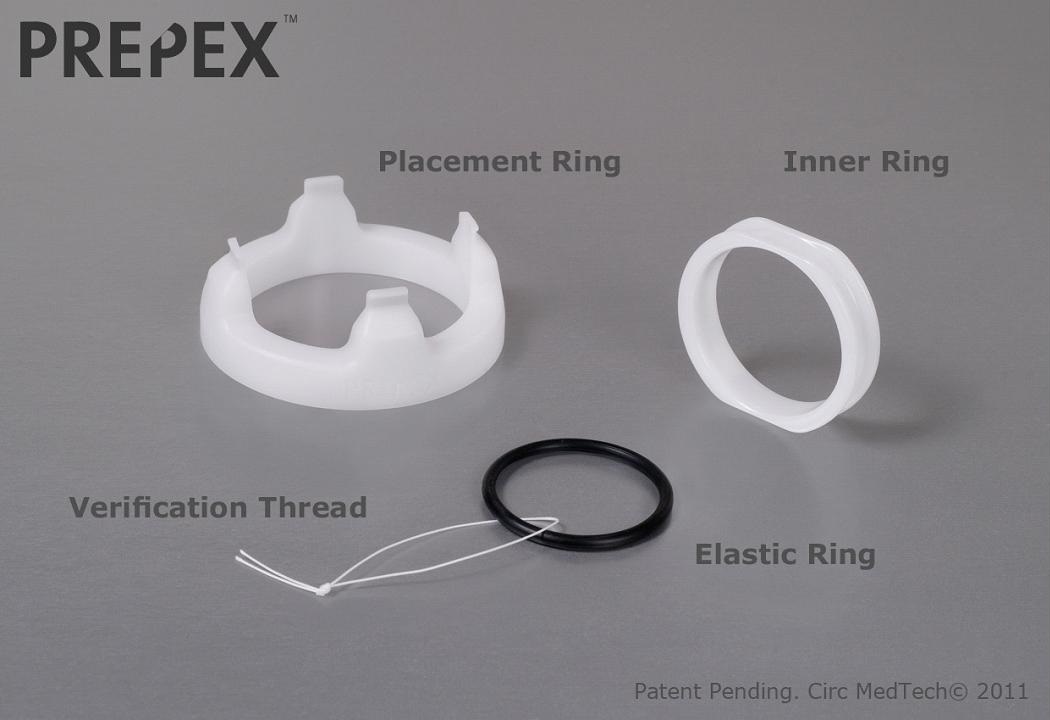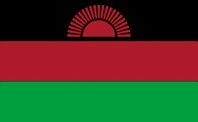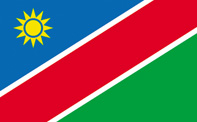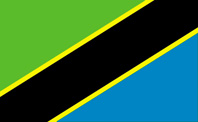The PrePex™ device
Developed in 2009/10 by Fuerst, Kilemnick & Shohat and marketed by the company Circ MedTech Limited, PrePex is a non-surgical medical device for male circumcision currently (2014) in use as part of a comprehensive HIV prevention strategy in Sub-Saharan Africa.
It has been scientifically validated that circumcised men reduce their risk of acquiring HIV infection through heterosexual intercourse by 60% to 70%. Based on this evidence, the World Health Organization (WHO) and the Joint United Nations Programme on HIV/AIDS (UNAIDS) recommended in 2007 that voluntary medical male circumcision (VMMC) be offered as part of a comprehensive HIV prevention strategy in geographic areas with high prevalence of heterosexually transmitted HIV and low prevalence of male circumcision.
As a result UNAIDS and WHO in partnership with The US President’s Emergency Plan For AIDS Relief (PEPFAR), the Bill & Melinda Gates Foundation and the World Bank, announced an accelerated plan to scale up VMMC to approximately 20 million men in 13 target countries in Sub-Saharan Africa by the end of 2015, with the objective of saving roughly 3.4 million lives and US$16.5 billion due to averted treatment and care.
In order to provide the tools necessary to reach that goal, Circ MedTech developed the PrePex device to facilitate safe, simple, scalable and cost effective non-surgical adult male circumcision as part of a comprehensive HIV prevention plan.
Device components and procedure
 |
The device is disposable and comprised of four elements: Placement Ring, Inner Ring, Elastic Ring and a Verification Thread. The device stops the flow of blood to the foreskin tissue, due to the compressive force of the elastic ring. This initiates ischemic necrosis and the dead foreskin tissue naturally detaches or is easily removed after 7 days. The overall time for healing is 6 weeks, during which no sexual activity is permitted.
The device is not for self-use. The procedure has been clinically validated and peer reviewed as safe in the hands of low cadre nurses, who conduct the bloodless procedure in non-sterile settings in approximately 4½ minutes, without the need for injected anesthesia or sutures. PrePex is currently available in 5 different ring sizes.
A
video illustrating the PrePex procedure is available on the company’s website.
Contra-indications
The PrePex device should not be used in cases of phimosis or congenital abnormality.
Regulatory issues
PrePex is WHO prequalified, FDA cleared and certified CE Mark Class IIa. Circ MedTech is ISO 13485 certified.
Known use (as at February 2014)
PrePex is being used in 13 priority countries in Sub-Saharan Africa with high HIV prevalence and as such, the device is not yet available elsewhere.

Botswana
|

Kenya
|

Lesotho
|

Malawi
|

Mozambique
|

Namibia
|

Rwanda
|

South Africa
|

Swaziland
|

Tanzania
|

Uganda
|

Zambia
|

Zimbabwe
|
The Rwanda Ministry of Health, Uganda Department of Health, and the Zimbabwe Department of Health have adopted PrePex as an integral part of their national health programs. Rwanda is the first country to begin scale-up in February 2014 with a national campaign to circumcise 700,000 men. South Africa, Kenya, Zambia and Mozambique are in advanced stages for scale up. Tanzania, Botswana, Malawi, Lesotho, Swaziland and Namibia are running acceptability pilots.
Clinical Trials, Safety & Efficacy studies
The PrePex device was originally validated for safety and efficacy by the Government of Rwanda. Details were published in the Journal of Acquired Immune Deficiency Syndromes (JAIDS), edition date 08.September.2011. The study was audited on-site by WHO and Gates Foundation delegates.
Objectives:
To assess the safety and efficacy of the PrePex device for nonsurgical circumcision in adult males as part of a comprehensive HIV prevention program in Rwanda.
Results:
The entire procedure was bloodless, requiring no anesthesia, no suturing, and no sterile settings. Subjects had no sick/absent days associated with the procedure. Median time for complete healing was 21 days after device removal.
Conclusions:
The PrePex device was safe and effective for nonsurgical adult male circumcision without anesthesia or sterile settings and may be useful in mass circumcision programs to reduce the risk of HIV infection, particularly in resource-limited settings.
A comparative study followed, entitled HIV Prevention: Male Circumcision Comparison Between a Non-surgical Device to a Surgical Technique in Resource-Limited Settings: A Prospective, Randomized, Nonmasked Trial.
Background:
The study was designed to compare a new non-surgical device with surgical MC to assess nonsurgical male circumcision (MC) suitability for scale-up.
Methods:
Prospective, randomized controlled trial in Rwanda in which the PrePex device was used for nonsurgical MC and the dorsal-slit method for surgical MC (ratio: 2:1). Subjects were healthy adult male volunteers aged 21–54 years. The primary endpoint, set by World Health Organization, was to determine total MC procedure time.
Findings:
Of 217 eligible subjects, 144 were randomized to the PrePex/nonsurgical arm and 73 to the surgical arm. All subjects were circumcised in 10 working days. Nonsurgical MC with mean procedure time of 3.1 minutes (skin to skin), was significantly shorter than mean surgical procedure time (15.4 minutes skin to skin) (P < 0.0001).
Conclusion:
PrePex, the nonsurgical MC, takes significantly less time than surgical, is as safe, does not require injections or sterile settings, is bloodless and seems to be suitable for nurses.
Click here to read the clinicaltrials.gov report.
Next came a study intended to determine the skill level required for ad-hoc trainees, entitled One-Arm, Open-Label, Prospective, Cohort Field Study to Assess the Safety and Efficacy of the PrePex Device for Scale-Up of Nonsurgical Circumcision When Performed by Nurses in Resource-Limited Settings for HIV Prevention.
Objective:
To assess the safety and efficacy of the PrePex device when circumcision is performed by lower cadre nurses.
Results:
All 518 subjects from the pilot and pivotal phases achieved complete circumcision. There were 5 Adverse Events (AEs) on 4 subjects (rate of 0.96%, 95% confidence interval: 0.31 to 2.24). All AEs were moderate and were resolved with simple intervention.
Conclusions:
The study demonstrated that circumcision performed by nurses using the PrePex device is safe, effective, and easy to train. PrePex has the potential to help facilitate rapid, safe, non-physician male circumcision scale-up programs for HIV prevention.
Click here to read the Abstract. There is also a pay-per-view link to the full text.
Manufacturer’s claimed advantages and benefits
• No surgery
• No injected anesthesia
• No blood
• No cutting of live tissue
• No sutures
• No sterile settings
• Safe
• Faster than surgical surgery (average time of procedure 4½ minutes)
• Reported less painful than surgical procedure
• Better aesthetic results than surgical procedure
• No loss of work days for the patient
• Not visible under clothing and does not interrupt everyday activities (except sex! - Editor)
• Comes in a range of sizes
• Can be conducted by low cadre staff
• Easy to train
• Cost effective
• A scalable and sustainable solution for African countries
Questions and Answers about the PrePex device
Here are some questions raised in "Letters to the Editor" along with the answers given by Circ MedTech. To read additional frequently asked questions about PrePex, visit
http://prepex.com/PrePexFAQ.pdf
- Q: Why did Circ MedTech use military personnel as test subjects? They are not fully representative of the general population in several respects: Fitness, pain tolerance, diet, hygiene régimes, environmental factors that have infection control implications....
A: Kanombe is both a military and a district hospital. Only 5 patients out of 100 in the safety study were soldiers. In all the other studies held in Rwanda (clinicaltrials.gov ID NCT01284088), all patients were civilians.
- Q: Is it really the case that the foreskin is NOT at first severed in a PrePex circumcision, but left intact for a week to necrotise 'in situ'?
A: Yes, it is true. The device is left in situ for 7 days, until the foreskin is fully necrotized. This is part of what makes the patent pending device and method safe and simple to use, with very little training (you don’t even have to be a nurse). This also enables a bloodless procedure (no cutting of live tissue!), a critical factor in rural settings. There is no anesthesia (so no needles!), no blood, no sutures and no sterile settings required, as the device comes in contact only with intact skin. There were no infections or complications throughout the whole study from anyone while the device was in situ, confirming the safety of the technique. From discussions with patients after the study, one of the key benefits raised was that the procedure had no blood.
- Q: Adults only, or child sizes too?
A: For now, only adult sizes are readily available, but adolescent sizes (age of 13-17) are now in use, with WHO requiring that active surveillance must be followed until a minimum of 2,000 procedures have been completed, in at least three countries. Child sizes (0-13) have had clinical trials in Rwanda and a report has been submitted to WHO.
Accolades
In April 2012, PrePex won the Best Technology for Health Award and has also found favour with WHO’s Technical Advisory Group on Innovations in Male Circumcision.
In May 2013 the US Global AIDS Coordinator, Ambassador Eric P. Goosby stated, “...PEPFAR is ready to support countries that wish to introduce PrePepex™ right away. This will truly help save lives.”
PrePex was also featured on the
BBC Health Show on July 2011 in a special episode about male circumcision.
In 2015 Prepex won the Sutter Health Prize, one of the annual Tech Awards chosen by the Tech Museum of Innovation. These awards are all about making things better in third world countries. The ceremony is on 12th November, 2015 in San José, California. Read about the awards at
The Tech Awards website.
Copyright © 1992 - 2015, All Rights Reserved CIRCLIST.

